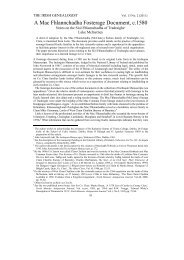Report Cover Vol I - Clare County Library
Report Cover Vol I - Clare County Library
Report Cover Vol I - Clare County Library
Create successful ePaper yourself
Turn your PDF publications into a flip-book with our unique Google optimized e-Paper software.
The <strong>County</strong> <strong>Clare</strong> Wetlands Survey Patrick Crushell & Peter Foss 2008<br />
____________________________________________________________________________________<br />
5.2.5 Habitat Diversity and Wetlands<br />
The varying geological, climatic and soil conditions referred to above have all contributed to a rich and<br />
diverse landscape within the county. The variety of wetland habitats found within <strong>Clare</strong> is explored in<br />
more detail in section 5.3.<br />
The most well-known and studied part of <strong>County</strong> <strong>Clare</strong> is without a doubt the Burren, renowned for its<br />
unique flora (and fauna). Plants occur here in abundance that are almost or totally unknown in the rest of<br />
Ireland. Alpine species are mixed with arctic-alpines and purely arctic types, and amidst these groups,<br />
Mediterranean species also find a suitable climate. The invertebrate fauna has also been examined, and<br />
the same trends have been discerned in it. It includes several species unknown in Great Britain. It is the<br />
mixture of geographical types that makes the Burren unique in Europe and of the greatest biological<br />
interest.<br />
The <strong>Clare</strong> coastline is also punctuated by areas of natural and scientific interest. These include the shore<br />
south of Spanish Point for its marine biology. The Cliffs of Moher and to a lesser extent of Loop Head<br />
support large nesting populations of seabirds, while on the south coast several estuaries, most notably<br />
the Fergus, are visited by huge numbers of wildfowl and wading birds. Inland there are also wildfowl<br />
resorts, Loughs Atedaun and Cleggan are good examples.<br />
Many of the limestone lakes of <strong>Clare</strong> contain and are surrounded by an interesting flora. Two of these are<br />
in the south, Ballycar Lough and Dromoland Lough, and as one goes north, elements of the Burren flora<br />
appear in the community. This is best developed at Lough Bunny.<br />
To the east, the old red sandstone stretches over to Lough Derg and above the drift is much covered by<br />
blanket bog, except where natural woodland has persisted. Lough Derg itself has an interesting flora, well<br />
shown at the mouth of the Scarriff River and including some juniper scrub (Goodwillie 1972).<br />
5.3 Wetland Habitats in <strong>County</strong> <strong>Clare</strong> – a brief description<br />
<strong>Clare</strong> contains a wide range of wetlands of high international and national importance. Due to the varying<br />
topography, hydrology, climate, coastline and soils present it has wetland habitats ranging from raised<br />
bogs, blanket bogs, fens, marshes, coastal lagoons, large riverine systems, variety of lakes, springs, wet<br />
woodlands and many more. <strong>Clare</strong> is likely to contain some of the finest examples of calcareous fens,<br />
springs and turloughs that occur in Ireland and Northwest Europe.<br />
In the section which follows, a brief description and illustration of each of the main wetland habitat types<br />
occurring in <strong>Clare</strong>, and being mapped as part of the <strong>County</strong> <strong>Clare</strong> Wetland Survey (CWS), are presented.<br />
In addition to the general habitat descriptions this summary introduction to habitats includes some<br />
additional information on the wildlife value of these habitats. An indication is also provided of the main<br />
threats faced nationally by the more ‘natural’ of these habitats deemed to be of high conservation<br />
importance, which is based on the NPWS report entitled ‘The Status of EU Protected Habitats and Species<br />
in Ireland’ (Anonymous 2008d).<br />
For a more detailed description of the wetland habitat types, the main floral species that occur in them,<br />
and detailed relationship of the Heritage Council classification system for habitats to the habitat<br />
classification system used in the EU Habitats Directive the reader is referred to Appendix 6a and 6b at<br />
the end of this report. The detailed habitat accounts in this Appendix are based on the Heritage Council<br />
Guide to Habitats in Ireland (Fossitt 2000).<br />
For further information on best practice management guidelines for many of the wetland habitats listed,<br />
the reader is referred to “The Living Farmland – A Guide to Farming for Nature in <strong>Clare</strong>” (Anonymous<br />
2008c) which provides practical advice on habitat maintenance and improvement for landowners and<br />
farmers. In addition the NPWS website (www.npws.ie) provides a range of guidelines to help with the<br />
protection, management and wise use of conservation worthy habitats and protected species including<br />
information on the Rural Environment Protection Scheme (REPS), Farm Plan Schemes, Notifiable actions<br />
inter alia. Furthermore the Irish Peatland Conservation Council have published a Management Handbook<br />
for Peatland which provides practical advice on habitat restoration (see www.ipcc.ie).<br />
16
















